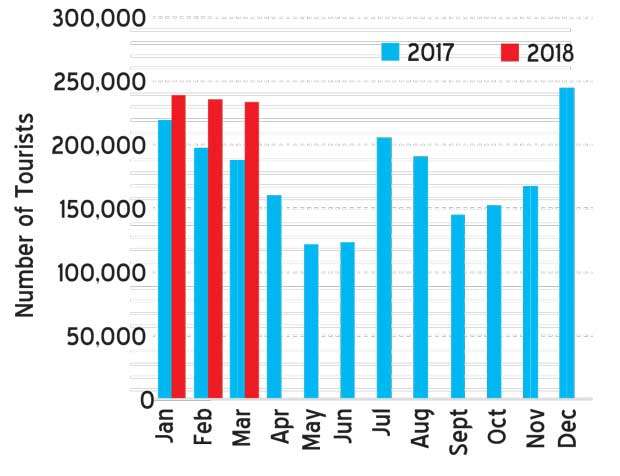10 Apr 2018 - {{hitsCtrl.values.hits}}

Despite the communal clashes that unsettled Sri Lanka’s hill country during the first two weeks of March, the tourist arrivals to the island nation in the same month grew 24.1 percent to 233,382, the data released by Sri Lanka Tourism Development Authority (SLTDA) showed.
However, this strong growth comes from a low base last year, due to the partial closure of the country’s main airport in Katunayake.
According to the SLTDA, Europe continued to be the largest source of tourist traffic to Sri Lanka, accounting for 53 percent of the total arrivals received in March 2018. Asia and the Pacific accounted for 38 percent of the total traffic, America 7 percent, Middle East one percent and Africa one percent.
India, the United Kingdom, Germany, China and France were Sri Lanka’s top five international tourist-generating markets during March. India was the largest source of tourist traffic with 13 percent of the total traffic received in March. The United Kingdom also accounted for 13 percent of the total traffic, while Germany, China and France accounted for 11 percent, 9 percent and 6 percent, respectively.
Tourist arrivals from India during March rose 13 percent year-on-year (YoY) to 30,583, while arrivals from the United Kingdom rose 56.1 percent YoY to 30,366.
Visitors from Germany rose 60.6 percent YoY to 24,423, while from France the arrivals rose 29 percent YoY to 14,818.
Tourist arrivals from China fell 4.8 percent to 21,101.
An analysis of arrivals by regions showed Europe leading the pack with 124,144 tourists during March, recording a growth of 44.5 percent YoY.
Arrivals from Asia and the Pacific edged up 2.2 percent YoY to 88,299, while arrivals from the Americas rose 61 percent YoY 16,006.
Tourists from Oceania, which includes Australia and New Zealand, rose 58.2 percent YoY to 9,966.
Visitors from the Middle East fell 26.6 percent YoY to 3,520, which could be directly attributed to the communal violence prevailed during the early weeks of the month.
To tame the violence that erupted between the extremist factions of Sinhala and Muslim communities, the government had to declare a state of emergency and ordered a social media blackout, which lasted almost a week, even after the hostilities ended. Due to the police curfew that prevailed, the tourists in Kandy were trapped in their hotels and had to use their passports as curfew passes to leave the area. However, there were no reports of any tourist being harmed.
Meanwhile, on a cumulative basis, tourist arrivals to Sri Lanka in the first quarter of 2018 rose 17.1 percent YoY to 707, 924.
Sri Lanka achieved 2.1 million tourists in 2017 despite the partial closure of the country’s main airport for about three months. The floods and the dengue epidemic also contributed to the lower than expected arrivals.
The government aims to attract three million tourists this year.
18 Nov 2024 4 hours ago
18 Nov 2024 5 hours ago
18 Nov 2024 5 hours ago
18 Nov 2024 7 hours ago
18 Nov 2024 18 Nov 2024